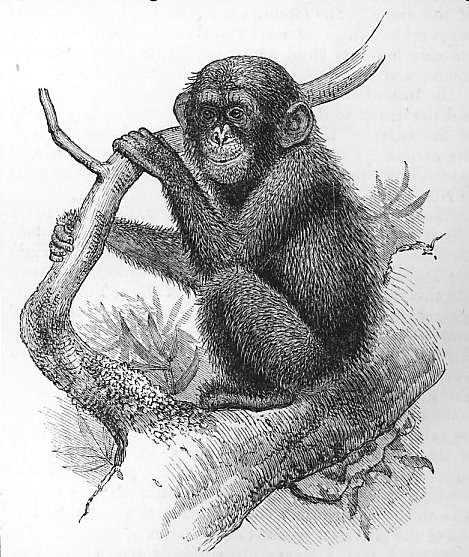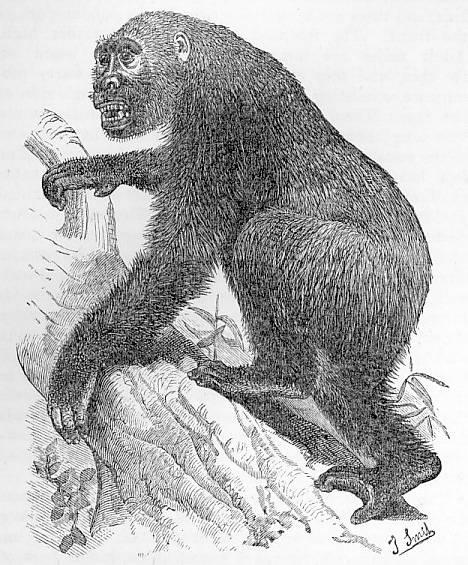1902 Encyclopedia > Ape > Ape: Family I - Simiadae, Sub-Family 1 - Simiinae. Chimpanzee. Gorilla.
Ape
(Part 4)
<
(B) Apes Classified by Family, Sub-Family and Genera (cont.)
Ape: Family I - Simiadae, Sub-Family 1 - Simiinae. Chimpanzee. Gorilla.
The chimpanzee and gorilla together form the genus Troglodytes. Both of these species agree with the orang in being destitute of any rudiment of a tail, in having no check pouches, and no naked spaces at the hinder part of the trunk, as also in possessing tusk-like canines, and in the habit of resting on the knuckles of the hand in walking on the ground and of mainly dwelling in trees.
The chimpanzee (T. niger) is found in Western Africa, from the Gambia to the Benguela, and extending inland to 28° E. long. It is the most man-like of the latisternal apes in the proportions of its arms, as these only reach a little below the knees when the body is placed upright. It is pf moderate stature, never appearing to exceed 5 feet in height. In disposition it is lively and intelligent, and its playfulness in captivity contrasts greatly with the lethargy of the orang. The forehead is not rounded, but a bony, supra-orbital ridge extends transversely above the eyes. Its ears are very large, and it has distinct eyebrows, eyelashes, and whiskers. The pollex reaches nearly or quite to the base of the first phalanx of the index of the hand, and thehallux to the proximal end of the second phalanx of the index of the foot. There is no os intermedium in the carpus. The laryngeal sacculus may, as in the orang, extend downwards to the axilla. There are thirteen pairs of ribs.

Fig. 2 -- The Chimpanzee (Troglodytes niger). From Mr Wolf's Sketches, vol. i, pl. 1.
The gorilla (T. gorilla) is also West African, but has a less extended range than the chimpanzee, namely, between the Cameroon and Congo rivers only. It is the largest ape known, attaining a bulk of body considerably exceeding that man, though, on account of the shortness of its legs, it never seems to exceed the height of 5 feet 6 inches. It was first made known to modern by Dr. Thomas Savage, but it appears to have been seen by Hanno of Carthage 150-1, in his voyage south of the pillars of Hercules.
The gorilla has not such dark hair as has the chimpanzee, being blackish-dun in colour, and becoming grey when old. Its skin, however, is black.
Its arms are longer than those of its congener, reaching half-way down the shin. Its pollex reaches but very little beyond the proximal end of the first phalanx of the index of the hand (slightly further than in the chimpanzee), and its hallux to about the distal end of the proximal phalanx of the index of its foot. The fingers and toes, however, are curiously syndactyle, being bound together by the integument to the ends of the proximal phalanges.
The forehead is not rounded, the supra-orbital crest being more prominent than even in the chimpanzee; the ears too are smaller relatively. The larynx is provided with enormous air-sacs, communicating with the ventricles and meeting over the trachea, and extending to the axilla with age. There is no os intermedium in the carpus, and there are thirteen pairs of ribs.

Fig. 3 -- The Gorilla (Troglodytes gorilla). From Trans. Zool. Society, vol. iv, pl. 43.
Footnote
150-1 See Pliny, Nat. Hist., ii. 169, v. 8, vi. 200, ed. Sillig.
Read the rest of this article:
Ape - Table of Contents
|

